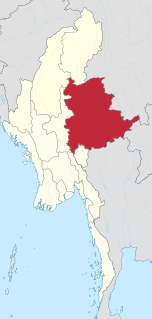| Myelat မြေလတ် | |
|---|---|
| Historical region | |
Picture of people in Myelat taken by Sir George Scott (1851–1935). | |
 A map of Shan State | |
| Country | Myanmar |
| Elevation | 880 m (2,890 ft) |
| Population (1897) | |
| • Total | 107,500 |
Myelat (Burmese : မြေလတ်) is a historical region of the southwestern Shan State of Myanmar. Originally this region included some of the smaller states typically ruled by "Myosas" (chief of town) or "Ngwegunhmus" (silver revenue chief), buffering the plains of Burma and the ethnic Shan states further east.

The Burmese language is the Sino-Tibetan language spoken in Myanmar where it is an official language and the language of the Bamar people, the country's principal ethnic group. Although the Constitution of Myanmar officially recognizes the English name of the language as the Myanmar language, most English speakers continue to refer to the language as Burmese, after Burma, the older name for Myanmar. In 2007, it was spoken as a first language by 33 million, primarily the Bamar (Burman) people and related ethnic groups, and as a second language by 10 million, particularly ethnic minorities in Myanmar and neighboring countries.
Historical regions are geographic areas which at some point in time had a cultural, ethnic, linguistic or political basis, regardless of present-day borders. They are used as delimitations for studying and analysing social development of period-specific cultures without any reference to contemporary political, economic or social organisations.
The fundamental principle underlying this view is that older political and mental structures exist which exercise greater influence on the spatial-social identity of individuals than is understood by the contemporary world, bound to and often blinded by its own worldview - e.g. the focus on the nation-state.

Shan State is a state of Myanmar. Shan State borders China to the north, Laos to the east, and Thailand to the south, and five administrative divisions of Burma in the west. Largest of the 14 administrative divisions by land area, Shan State covers 155,800 km², almost a quarter of the total area of Burma. The state gets its name from the Shan people, one of several ethnic groups that inhabit the area. Shan State is largely rural, with only three cities of significant size: Lashio, Kengtung, and the capital, Taunggyi. Taunggyi is 150.7 km north east of the nation's capital Naypyitaw.
Contents
The term "Myelat" is still in common use today, although the old political and administrative distinctions no longer apply.








